Keeping Birds and Cats Together: Safety Tips
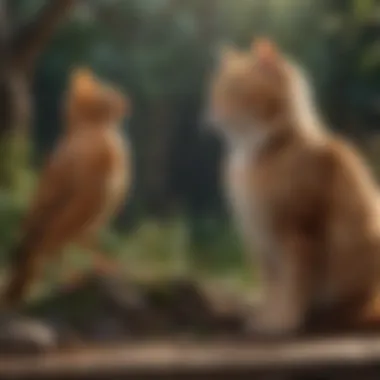

Intro
Deciding to welcome a bird into a home where a cat already resides isn't just a whim; it’s a nuanced decision requiring careful thought. Birds and cats each have their own unique qualities and instincts. For instance, cats are often natural predators, drawn to movement, while birds might view every twitch as an invitation or a threat. Balancing these instincts while fostering a harmonious environment is essential for the well-being of both pets. By evaluating factors such as behavior, safety measures, and environmental adjustments, pet owners can establish a nurturing, safe space for both their feline friends and feathered companions.
Care Tips
Daily Care Routines
Caring for both a bird and a cat presents an intricate daily routine that requires organization. Birds need daily interactions, fresh food, and clean water. Meanwhile, cats need their playtime, litter box maintenance, and, of course, their daily feed. It’s vital to allocate specific times for both pets to ensure they receive ample attention without stepping on each other’s toes. A consistent schedule can help sort out feeding times – for instance, feeding the bird in the morning and the cat afterward, thus minimizing any potential stress.
Cage Setup and Maintenance
The bird’s cage should be thoughtfully placed where the cat cannot easily access it. A sturdy, spacious cage with appropriate perches and toys makes for an ideal home for a bird. Regularly checking the bars for any wear and tear is crucial, as a crafty cat might try its luck at getting to its new neighbor. Keeping the cage clean can’t be overlooked; dirty cages can lead to health issues. A weekly deep clean, alongside daily spot checks, is a good practice.
Hygiene and Cleaning Practices
Maintaining hygiene not only protects both species from diseases but also promotes overall health. Bird droppings and uneaten food can create unsanitary conditions. It's wise to set up a cleaning schedule, allocating time daily for quick tidying, and a more thorough cleaning each week. It may be helpful to use non-toxic cleaners that won't harm any curious paws or beaks.
Seasonal Care Adjustments
As the seasons change, so can the needs of both the bird and cat. During winter, humidity levels can drop drastically, which may affect your bird. Utilizing a humidifier can help maintain optimal levels. In summer, it's critical to monitor both pets for signs of overheating; an outdoor space can be wonderful, but ensure it's safe for both animals.
Behavioral Insights
Understanding Bird Body Language
Birds communicate largely through body language. Recognizing signs of comfort or stress in your feathered friend is vital. A bird that ruffles its feathers may be feeling threatened or anxious, while a comfortably perched bird will present an upright stance. Learning these signals lays the groundwork for minimizing stress in the presence of the cat.
Common Behavioral Issues and Solutions
Both species may exhibit behaviors fueled by stress or jealousy. A cat may stalk the bird's cage or show increased hunting behavior. Solutions might involve providing plenty of distractions for the cat while training the bird to be calm during interactions. For instance, gradual introductions, controlled environments, and de-escalation techniques when tensions rise can ease the transition.
Positive Reinforcement Techniques
Training the cat to associate the bird's presence with positive experiences can work wonders. Offering treats or engaging in play when the cat remains calm can help build a peaceful coexistence mindset. For the bird, rewards for calm behaviors, like remaining quiet when the cat is nearby, solidifies good habits and helps build confidence.
Social Interaction Needs
Both birds and cats thrive on social interactions, albeit in distinct ways. Birds are social creatures that flourish in environments where they can engage with their human companions and even other pets. Ensuring each pet gets its fair share of attention is important; consider creating separate but safe zones where they can observe each other without direct contact, minimizing any anxiety.
Nutrition Guides
Essential Diet Components
Proper nutrition is crucial for both pet types. Birds thrive on a balanced diet of pellets, seeds, fruits, and vegetables, while cats are obligate carnivores needing meat-based diets. If allowed access to each other's food, dogs might explore, leading to health issues. It’s essential to keep both pets’ food in clearly designated locations, away from each other.
Safe and Toxic Foods
Knowledge of what foods are safe or dangerous to each pet can save lives. Birds often enjoy leafy greens, while certain foods like avocado can be toxic. Likewise, while cats can consume many proteins, chocolate and onions are off-limits. A thorough conversation with a veterinarian can clarify these concerns, helping to create a secure feeding routine.
Supplements and Treats
Adding variety through treats or supplements is a good way to keep your pets engaged. Certain seeds, along with cuttlebones for birds, promote beak health, while cats could benefit from dental treats. Monitoring intake to avoid overindulgence is essential.
Feeding Strategies for Different Species
It's common to have separate feeding schedules. For instance, feeding the bird during the mornings while the cat enjoys its meals could reduce conflicts. When introducing a new food or supplement, do so gradually to prevent any digestive issues.
Wellness and Health
Routine Health Checkups
Regular vet visits are non-negotiable for identifying potential health issues early. Scheduling annual checkups for both pets can ensure no underlying problems go unnoticed. Be sure to keep records organized to help share medical histories.
Identifying Symptoms of Illness
It’s important to be observant; changes in behavior or appearance can signal health problems. A cat becomes lethargic or a bird refuses food could mean something is amiss. Understanding early warning signs can lead to prompt treatment and improve health outcomes.
Preventative Care and Vaccinations
Consultations with AVMA-certified veterinarians regarding vaccinations are essential. Both species may require different care, and adhering to recommendations can prevent outbreaks of common illnesses.
Mental and Emotional Well-being
Making sure both pets are mentally engaged is key. Birds flourish with mental stimulation, while cats need play often to prevent boredom. Interactive toys suited for both species can keep them entertained while giving you peace of mind.
Enriching Activities
Toys and Playtime Ideas
Providing stimulating toys is essential. Birds might enjoy shredders, swings, and mirrors, while cats can be entertained with laser pointers or feather wands. Playtime must be scheduled as an essential part of their routine.
Training and Tricks
Engaging both pets in training exercises fosters bonds and keeps them stimulated. Teaching a cat to respond to commands or a bird to mimic sounds is rewarding for both owner and pet. Consistency is key in reinforcing behaviors and skills.
Outdoor Activities and Interaction
If safe, spending time outdoors can be a wonderful escape. Harness training for birds or leash training for cats offers them a taste of the great outdoors. Supervision is crucial, as any distraction could lead to chaotic encounters.
DIY Projects for Mental Stimulation
Constructing simple toys or activities at home can enrich the lives of your pets. Homemade foraging toys for birds can keep them engaged, while cats love puzzles to solve for treats. Engaging their minds helps keep both pets mentally sharp.
Coexisting with a bird and cat isn't just possible; it can be a rewarding journey that brings much joy to both. Understanding their needs lays the groundwork for a peaceful and loving environment.
Understanding Cat and Bird Dynamics
The association between cats and birds is naturally fraught with complexity, primarily due to the instinctual predatory behaviors in felines and the inherent vulnerabilities of avian creatures. By grasping the dynamics at play between these two species, pet owners can make informed decisions about cohabitation and develop strategies that uphold the safety and well-being of both pets.
Understanding these interactions encompasses a myriad of factors, ranging from the biological predispositions of each animal to their behavioral idiosyncrasies. Familiarity with these aspects enables pet owners to create an environment that satisfies the needs of both their cat and bird, all while minimizing potential risks. Such preparation isn’t merely precautionary; it is foundational in cultivating a peaceful home where both species can thrive.
Natural Predatory Instincts
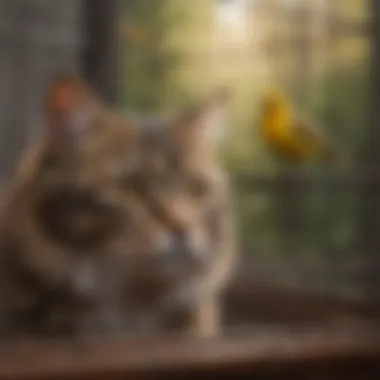
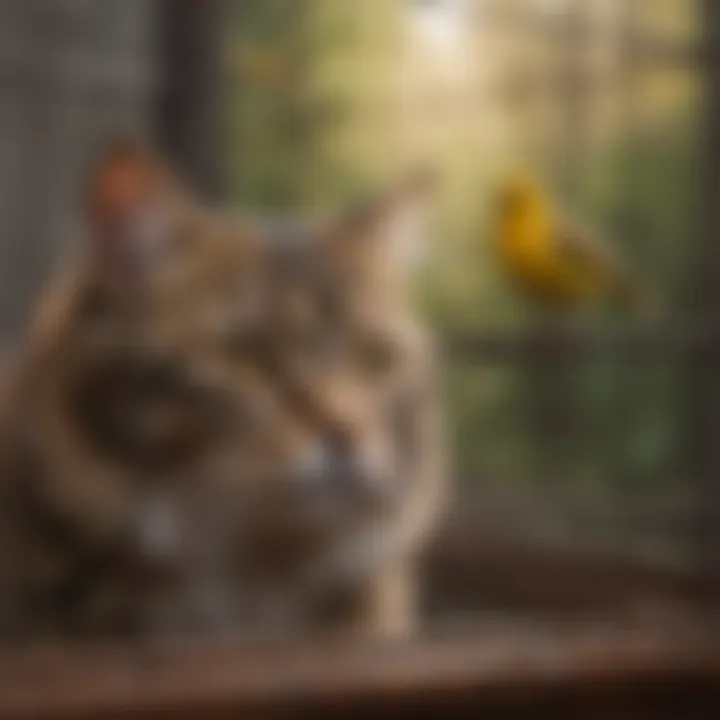
Cats are equipped with an array of innate predatory instincts that have evolved over time. This is embedded in their DNA—every twitch of their ears, every swish of their tail points to a hunter at heart. A domestic cat’s hunting prowess often translates to a fascination with small, flighty animals like birds. It's not uncommon to see a cat fixate on a chirping pet bird, eyes wide, body low to the ground as if stalking its prey in the wild.
Understanding this natural inclination is crucial for pet owners. Cats have sharp claws and teeth designed for catching and killing, which means that their interest in birds is not just benign curiosity. When a cat spots a small creature, a visceral reaction triggers; they might pounce without a second thought. Owners should recognize that playful swatting and stealthy stalking may very well be rooted in deep-seated instinctual behavior rather than simply a desire to play. Considering this instinct ensures the precautions taken in introducing a bird to a feline exist on solid ground.
Behavioral Characteristics of Cats
Each cat possesses a distinctive personality shaped by its breed, early socialization, and environmental factors. While some cats may appear docile and uninterested in birds, others display a natural curiosity or outright predatory behavior. This variation complicates the equation and highlights the necessity of understanding each individual cat’s traits before assuming compatibility with an avian friend.
Traits to observe include:
- Playfulness: Cats often pounce or respect an imaginary prey, a cue to their playful nature.
- Territorial behavior: Cats may exhibit possessiveness over their home space, causing stress for a new bird.
- Attention span and focus: A cat's ability to concentrate on a bird can reveal its level of predation.
An attentive owner is prudent in gauging these characteristics. Cats demonstrating intense focus or agitation around birds should not be trusted in unsupervised settings. Recognizing and adapting to these behavioral traits helps establish a balance within the household and can prevent unfortunate incidents.
Birds as Prey Animals
From the perspective of the bird, their existence is largely shaped by their status as prey animals. Unlike cats, birds are not equipped to defend themselves against large predators, making them vulnerable to even the slightest provocation. A small bird may see a cat as a looming threat simply by virtue of size alone.
The survival instincts in birds are finely attuned to their environment. They rely heavily on their ability to detect danger, often exhibiting flighty behavior when feeling threatened. Birds tend to feel safest in spacious, elevated areas, away from prowling cats.
Factors that inform a bird's reaction include:
- Stress levels: Birds may become anxious in the presence of potential threats, which can manifest as feather plucking or excessive vocalization.
- Social behavior: Some birds are more social and curious than others, impacting their interactions with cats.
- Flight ability: Birds who can't fly or are hindered physically are particularly vulnerable and may need special attention.
Thus, recognizing that birds are inherently prey shapes how pet owners should structure their living spaces and interactions. A solid understanding of their instinctual behaviors helps in crafting a habitat that feels secure for these delicate creatures while coexisting alongside a cat.
In essence, grasping the dynamics between cats and birds lays the groundwork for harmony in a multi-pet home. It is not just about cohabitation; it’s about fostering a relationship that honors the needs and instincts of both species.
By taking time to study these unique behaviors and instincts, pet owners not only prioritize safety but also pave the way for a more peaceful and balanced household.
Assessing Your Cat’s Behavior
Understanding your cat's behavior is paramount when considering if a bird can become a part of your household. Cats possess instinctual predatory tendencies that can pose a significant risk to birds. Therefore, assessing these behaviors is not only crucial for the safety of your avian companion but also informs your approach to managing their interactions.
Socialization and Temperament
The personality of your cat plays a pivotal role in determining whether cohabitation with a bird is feasible. A cat that is generally independent, aloof, or unsociable might be less interested in engaging with a bird, possibly keeping peace while coexistence ensues. On the other hand, a social cat, one that often seeks engagement or stimulation, might display more curiosity towards a new pet.
In this context, consider how your cat behaves around others, including their interaction with humans and any past pets. For instance, if your cat is known to hiss or avoid others, it could indicate that they may not be inclined toward a new family member, allowing for a more harmonious relationship. Notice any patterns in how your cat reacts to creatures outside, such as squirrels or birds in your yard. This could give you insight into their curiosity or predatory instincts.
History with Other Pets
Examining your cat’s history with other pets can shed light on possible future interactions with a bird. If your feline has previously shared its home with other small animals in a peaceful manner, it can suggest a level of adaptability and social acceptance. Conversely, if your cat has shown aggression or a strong interest in trying to chase or play too rough with other pets, introducing a bird might lead to stress and danger.
Sometimes, the behavior observed can be related to the type of other pets the cat encountered. For example, cats generally don't treat cats or dogs as prey, but a small animal like a hamster or a rabbit might trigger their hunting instincts. Engaging an animal behaviorist for additional insights could be invaluable in understanding these past interactions to gauge the readiness of your cat for a new companion.
Signs of Aggression or Curiosity
Being vigilant about your cat's signs of aggression or curiosity is essential in ensuring a safe environment for your future bird. Aggression can manifest in various ways: growling, swatting, or intense staring could all be indicators that your pet might pose a threat to a more fragile species like a bird.
Curiosity, on the other hand, may show itself through playful pouncing behavior, even if it looks harmless. Cats are known for their playful pursuit of moving objects, and in the event of a new bird flapping its wings or chirping, this may trigger an instinctive chase response.
A few common signs to watch for include:
- Staring: A focused gaze may indicate intent.
- Tail: A tightly curled tail might show agitation, while a flicking tail could represent excitement or overstimulation.
- Body Language: A lowered head and crouched posture might suggest preparation to pounce.
Understand that neither curiosity nor aggression should be underestimated. The well-being of both pet species demands that a solid understanding of your cat’s behavioral tendencies forms the foundation for their eventual introduction.
Choosing the Right Bird Species
Selecting the appropriate bird species can be a game changer for creating a peaceful environment when you also have a cat at home. Birds vary widely in their temperament, needs, and behavior, and finding one that can coexist comfortably with your feline companion is essential. Understanding these differences is crucial for fostering a harmonious relationship between the two species, which might not always be possible with all bird types.
Understanding Species Differences
Bird species come in a variety of shapes, sizes, and personalities. Each species has its own behavioral quirks and requirements. This isn't just a matter of choosing a pretty face; some birds are far more assertive, while others are easier to manage around other pets.
For example, larger birds like macaws and cockatoos often have incredibly strong beaks and can be territorial, making them less than ideal candidates if a cat is involved. Conversely, smaller birds such as budgies or canaries tend to have a more docile nature, which may make them less intimidating to a curious cat.
- Social Structure: Some birds thrive on social interaction and can handle another pet's presence without stress, while others may feel threatened.
- Activity Level: High-energy breeds could provoke your cat's hunting instincts more than a calm species would.
Understanding these species differences can help you choose a bird companion that is more likely to live peacefully alongside a cat.
Calmer Species Options
When it comes to finding a bird that can coexist with cats, calmer species bring several advantages. These birds are generally more adaptable and less likely to trigger your cat's predatory instincts. Consider the following options:
- Budgerigars (Budgies): These small parrots are known for their gentle dispositions. Budgies are social and often enjoy interacting with people, rarely displaying aggressive behaviors.
- Cockatiels: Another smaller parrot, cockatiels are soft-natured and can be quite affectionate. Their calm demeanor makes them accessible for multi-pet households.
- Lovebirds: These little characters are often playful but typically exhibit less aggressive behavior than some of their larger cousins.
Selecting a bird from these calmer categories can reduce stress for both your bird and cat. Remember, the more relaxed your bird is, the less likely it is to invoke your cat's predatory drive.
Recommended Species for Multi-Pet Households
Not every bird species will mesh well with cat energy. If you’re aiming for a household filled with both feline and avian friends, carefully curating your choice is crucial. Here are some recommended species:
- Parakeets: These playful birds can thrive in group settings and are generally less ruffled by the presence of other pets. Their social nature encourages them to remain calm and collected.
- Finches: Relatively small and peaceful, finches are usually kept in groups. Their gentle chirping adds a lovely ambiance without being overly demanding.
- Canaries: Known for their beautiful songs, canaries are also non-aggressive. They can tolerate the presence of a cat as they enjoy spending their time sitting calmly in their cages or aviaries.
Choosing birds that can gracefully share space with a curious cat can set the groundwork for fostering a respectful environment. With this careful selection, you’ll be on the right track toward achieving a serene coexistence.
Preparing Your Home for Both Pets
When the prospect of housing a cat and a bird in the same home springs to mind, the first consideration should always be the setting itself. A mere friendship between your furry feline and feathered friend is not something that magically occurs without a plan in place. You have to prepare your home to support the needs of both, ensuring a safe and harmonious environment is paramount.
The setup can be the foundation for a peaceful coexistence; it’s about creating boundaries and safe havens that work for each pet’s comfort and security.
Creating Safe Spaces
Establishing safe spaces for both your bird and cat is crucial. Birds thrive in environments where they can feel secure and away from predatory threats. Providing areas where your bird can retreat is vital; be it a cozy corner with soft lighting or a higher perch that feels out of reach from the cat's curious paws.
For the cat, having its own sanctuaries — like cat trees or shelves that reach the ceiling — allows for vertical space where it can observe from above without the risk of being scolded or startled. This separation is essential not only for the pet’s peace of mind but equally for your own, as it minimizes potential friction between them.
- Bird Recommendations: Consider places where they can fly slightly while feeling safe. Put their cages where light is plentiful, but they can’t be easily accessed.
- Cat Recommendations: Give your cat elevated spots with scratching posts; they appreciate viewpoints to survey their domain.
Cages and Perches Placement
The placement of cages and perches significantly impacts the living arrangement. Cages should be placed in areas that provide your bird with stimulation and visibility without putting it directly in the cat's line of sight. The distance helps alleviate stress for both pets. Birds are naturally nervous creatures, and placing their cage higher up and away gives them a feeling of security and reduces anxiety.
Perches should be arranged within the cage to encourage exercise and play. Vary the height and widths to mimic a natural landscape, giving your bird opportunities to climb and move around. To minimize risk, avoid placing the cage in areas where the cat tends to roam freely. Here are a few tips for cages and perches placement:
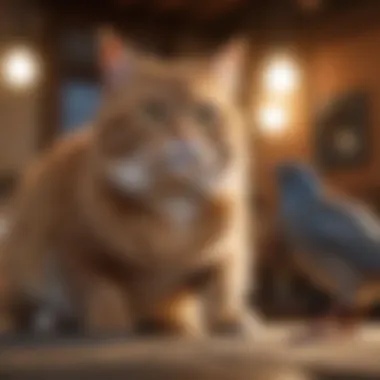
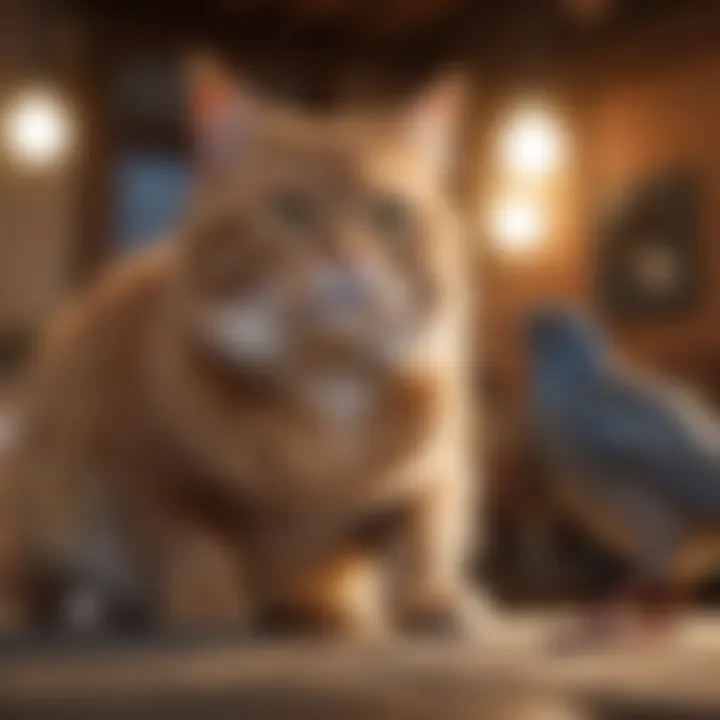
- Avoid sunlit spots. Too much heat can lead to uneasiness for birds.
- Use sturdy cages. Make sure the cage is made of durable materials to withstand curious nudges.
- Regular rotation of toys and perches. Keeping your bird engaged can reduce the chances of perceived threats.
Designing a Cat-Free Zone
Designing a dedicated cat-free zone is another vital aspect of preparing your home. This is the sanctuary where your bird can truly relax without the worry of being pawed or startled. Using barriers like baby gates or closed doors can effectively create a safe haven.
The bird's area should contain not just the cage, but also toys, food, and necessities that allow the bird to stretch and refresh. When selecting a space for this, think about rooms that don’t serve as thoroughfares in the house, where the cat won’t naturally wander.
Take the time to design a comforting, quiet environment. Some suggestions include:
- Lighting: Soft, indirect light can make a space feel safe.
- Sound: White noise machines can drown out potential stressors that might spook the bird, such as faint meows.
- Decoration: Foliage or bird-safe plants can create a serene atmosphere.
"Safe spaces allow pets to know that they have a zone they can retreat to, lessening anxiety while encouraging healthy interaction when the time is right."
In essence, preparing your home for both a cat and a bird isn't just about keeping them apart; it's about fostering a nurturing environment that respects their instincts and personalities. Thoughtful arrangements can turn your home into a peaceful coexistence of two seemingly oppositional forces.
Introducing the Bird to the Cat
Integrating a bird into a home with a cat is no small feat; it calls for careful planning and a clear strategy. The importance of introducing your bird to your feline friend cannot be understated. This process can set the stage for how well your two pets will coexist. If done right, it can create a harmonious atmosphere where both species feel safe and content. Conversely, a rushed or careless introduction might lead to unwanted stress or even harm.
Understanding that not all cats share the same temperament is critical. While some may be indifferent or even protective of the new feathered addition, others might exhibit hunting instincts. Thus, knowing the right steps to take is essential.
Gradual Preambles
One of the most prudent approaches when bringing a bird into a cat's territory is to facilitate gradual introductions. The idea here is to allow both animals to acclimate to each other's presence without direct contact at first.
Start by keeping the bird in its cage, positioned in a common area where the cat typically roams. Ensure the bird feels safe inside its cage, perhaps adding some favorite toys to make it more comfortable. This setup enables the cat to observe the bird from a distance, granting it the chance to satisfy some of its curiosity without any real threat to the bird's safety.
Over time, repeat this process so that both animals begin to understand that the other exists in their environment. You might notice the cat’s interest diminishes as time passes, or perhaps it grows more engaged. Either way, this observational step is crucial.
Monitoring Their Interactions
Once you've observed your pets from afar for a reasonable period, it may be time to initiate some monitored interactions. Here, keen observation becomes your best ally. Introduce short sessions where both pets are present but ensure the bird remains in its cage during these interactions, at least for the beginning phase.
Pay attention to body language—yours and theirs. Cats might display signs of excitement, nervousness, or aggression, and knowing what to look for can help in making timely decisions. Look for the cat's ears perked up or if it’s vocalizing intensely; that could be a signal to intervene.
Conversely, observe the bird for any signs of distress. A loud chirp or erratic movements could indicate fear. If certain behaviors emerge that spell trouble, steer both animals back to their safe spaces, reiterating the safety of each pet.
Positive Reinforcement Techniques
Employing positive reinforcement can be a game-changer in making introductions between your cat and bird successful. The basic premise is straightforward—reward desired behaviors. For instance, give your cat a treat whenever it remains calm when near the bird's cage.
You can also use verbal praises or affectionate strokes to reinforce its good behavior during these sessions. For the bird, rewards such as favorite treats or gentle spoken affirmations can help in associating the cat with something pleasant rather than alarming.
Over time, as both pets demonstrate a readiness to coexist, you may gradually begin to allow for more interactions, always with close attention and positive reinforcement at the forefront.
Remember: Patience is often key in nurturing a relationship between your cat and bird. Each step forward should be celebrated, no matter how small.
Behavioral Training for the Cat
In the quest for a harmonious home that includes both bird and cat, understanding and implementing behavioral training for your cat emerges as a crucial undertaking. Cats are remarkable creatures with a penchant for curiosity and instinctual behaviors that can sometimes clash with the presence of a pet bird. By focusing on training, pet owners can significantly lower risks associated with predatory tendencies and ensure a more peaceful coexistence.
Training your cat is akin to establishing a common language between you two. When your cat grasps the boundaries and learns to respond to commands, both of you can navigate the shared space much more smoothly. Achieving successful training requires patience, consistency, and a solid understanding of your feline’s nature.
Desensitization Methods
Desensitization methods play a key role in helping your cat acclimate to the presence of the bird. The goal is to gradually expose your cat to bird sounds and sights in a controlled manner. Start with recordings of bird calls, played softly at first, gradually increasing the volume as your cat becomes familiar. It’s crucial to observe their reactions during this process — if your cat shows signs of anxiety, dial back the intensity.
A few suggested techniques include:
- Short Sessions: Keep the exposure sessions brief to prevent overwhelming your cat.
- Distance Training: Initially place the bird’s cage out of reach, slowly introducing closer proximity as comfort grows.
- Use of Props: Employ toys that mimic bird movements to divert your cat’s hunting instinct, helping them understand that birds are not merely prey.
Through consistent exposure using these methods, you will help your cat recognize that birds can be part of their environment without being a target.
Use of Commands and Cues
Training your cat in commands and cues is another vital aspect that can be enforced to ensure safety. Commands such as "leave it" or "stay" can be essential for managing any interactions with the bird. Begin training with simple commands in a distraction-free environment. Use a calm tone and an even demeanor, which helps your cat feel secure.
- 'Leave It' Command: This directs your cat away from the bird when necessary. Start with less enticing objects so your cat can learn the command without the distractions of a moving target.
- 'Come' Command: Encouraging your cat to respond to your call can enhance supervision and control.
Repetition is key. With enough practice, your cat will respond to cues instinctively, allowing you more freedom in their interactions with your bird.
Reward Systems
Implementing reward systems is fundamental in reinforcing positive behavior. Cats respond well to rewards, which can include treats, praise, or gentle petting. When your cat successfully follows a command or displays calmness around the bird, timely rewards create a positive association.
To effectively establish a reward system, consider the following:
- Timing: Always reward immediately after the desired behavior to strengthen the association.
- Variety of Rewards: Experiment with different types of treats to discover what excites your cat, keeping them engaged and eager to learn.
- Consistency is Crucial: Be consistent in rewarding positive behaviors — this helps to establish a strong connection between actions and outcomes.
By employing these behavioral training methods, you can maneuver the complex dynamics of having both a cat and a bird under one roof. It’s a process that takes time, but with patience and effort, you can foster a household where both your feline and avian companions can thrive.
Ensuring the Bird’s Safety
When pondering the prospect of cohabiting a cat and a bird, the paramount concern undoubtedly centers around the bird's safety. Birds are inherently vulnerable creatures, often considered delicate compared to their feline counterparts. Hence, understanding the intricacies of safeguarding these feathered friends is critical for anyone looking to blend these two worlds. Not only does it protect the bird, but it also ensures that stress levels remain low in both pets, fostering a balanced ambiance in your home.
Supervised Interaction
One effective way to ensure your bird’s safety is through supervised interaction. This means that any time your cat and bird share the same space, an adult should be present. Think of it like keeping an eagle eye on things, ensuring that the cat's predatory instincts don't kick in at an inappropriate moment.
During these supervised sessions, observe both pets carefully. Not only might your cat display a curiosity that borders on hyperactive, but the bird might also react defensively if it feels threatened. Make sure the interactions are brief at first. Start with the bird inside its cage and the cat nearby, gradually increasing the exposure time as both animals acclimate to one another.
"Patience is the key when introducing any new pet into an existing pet household."
This approach sets the stage for safer, more controlled encounters in the future.
Safe Enclosures
Another pillar in ensuring your bird's safety is investing in high-quality, secure enclosures. A sturdy cage serves not only as a home for your bird but as a fortress against curious paws. Look for cages made of durable materials, with bars that are spaced closely enough to prevent the cat from reaching its paw inside.
Also, pay attention to the cage placement; it should be in a part of the house where the cat cannot easily jump to it. Avoid areas that are high-traffic or prone to chaos, where a sudden movement might startle the bird.
Here are some traits to consider in a good cage:
- Robust construction: Choose metal cages that can withstand a curious cat's attempts to paw through.
- Size: Ensure there’s enough room for the bird to spread its wings and move comfortably.
- Accessibility: Easy access points for cleaning and feeding, while minimizing the chance for escape.
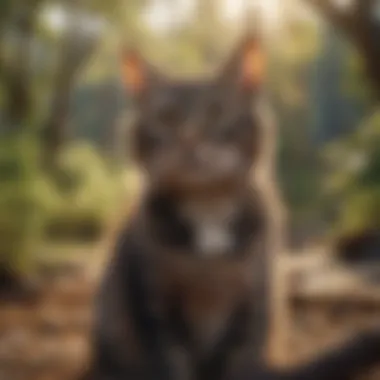

Emergency Preparedness
In any cohabiting scenario, it’s wise to plan for the unexpected, and preparing for emergencies is no exception. Be equipped with a strategy in case of an incident.
Here are some basic steps:
- Know Your Bird’s Limits: Familiarize yourself with signs of distress in your bird. Rapid breathing or fluffed-up feathers can indicate fear or agitation.
- Create a Safety Plan: Designate a specific room or space where the bird can be immediately secured if a situation arises. This could mean having a separate bird room or even a carrier handy for quick transport.
- Stay Calm: Your demeanor can influence how the animals react. In case of unexpected stress, keeping cool can help both pets regain their composure faster.
By ensuring consistent supervision, providing safe enclosures, and having a well-thought-out emergency plan, you significantly reduce risks. Always keep in mind that the goal is to foster a secure environment for both your feline and avian companions. Through diligence and careful planning, living with both can be a rewarding experience.
Recognizing Signs of Stress
Recognizing signs of stress is crucial when attempting to create a harmonious atmosphere for both cats and birds. Stress can lead to significant health issues and behavioral problems in both animals. Birds are known to be particularly sensitive to their environments, and even subtle changes can cause distress. Understanding and identifying the signs of stress can help pet owners take proactive measures to ensure the well-being of their feathered friends while safely integrating them into a home that includes cats.
Behavioral Indicators in Birds
Birds communicate their emotional states through various behaviors. Recognizing their signals is paramount in mitigating stress. Here are key behavioral indicators that a bird might be experiencing stress:
- Excessive vocalization: If a generally quiet bird begins to chirp or squawk excessively, it might be trying to communicate stress or discomfort.
- Feather plucking: This is a common sign of stress in birds. If a bird begins to remove feathers, it may indicate anxiety or frustration.
- Hiding or avoidance: When a bird retreats to a corner of its cage or shies away from interaction, it's usually a sign it feels unsafe or threatened.
- Significant changes in appetite: A noticeable decrease or increase in food intake can hint at stress levels that need attention.
- Aggressive behavior: If a bird seems more irritable or aggressive towards their owner or other pets, this could signal that they are stressed about their living situation.
What to Watch for in Cats
Cats can also exhibit various behaviors that indicate stress, especially in a multi-pet household. Understanding these warning signs allows for timely intervention:
- Hiding: If your cat suddenly becomes more withdrawn, preferring tight spaces or corners, this could signal stress.
- Aggression or overactivity: A normally calm cat might display increased aggression towards other pets or even their owners when stressed.
- Litter box issues: Changes in bathroom habits, such as urinating outside the litter box, may indicate anxiety or stress in your feline friend.
- Change in grooming habits: Cats may either over-groom or neglect their grooming routines in response to stress.
- Vocalization changes: If your cat starts to vocalize more frequently or in a different tone than usual, it may be expressing discomfort.
Intervention Strategies
Recognizing signs of stress is only half the battle; knowing how to respond properly is just as essential. Here are some interventions that pet owners might consider:
- Create a safe space: Ensure that both your cat and bird have dedicated areas where they feel secure and can retreat to when stressed.
- Limit exposure: Gradually introduce your pets to each other, allowing them to adjust to each other's presence without overwhelming them.
- Utilize positive reinforcement: Reward calm behavior with treats or praise for both pets. This can help them associate each other with positive experiences.
- Regular check-ins: Monitor your cat's and bird's behavior regularly to catch any signs of stress early on. If either pet shows signs of distress, be prepared to separate them and assess the situation.
Prompt recognition of stress signs allows for better management of your pets' environments, ensuring their safety and comfort.
Ensuring the well-being of both cats and birds requires a vigilant eye and active management of their surroundings. By being adept at recognizing the signs of stress and knowing how to intervene effectively, pet owners can foster a peaceful and nurturing environment for both species.
Long-Term Coexistence Strategies
Creating harmony in a home where a cat and a bird live together is no walk in the park; it demands careful planning and continual adjustment. Long-term coexistence strategies allow both pets to thrive, ensuring that their individual needs are met while minimizing conflicts between them. This section delves into a variety of considerations, highlighting why long-term strategies are vital for both cat and bird owners.
Daily Interactions and Engagement
Daily interaction plays a crucial role in building a peaceful coexistence. Monitoring interactions doesn't merely cover ensuring that the cat and bird are in the same physical space; it means fostering positive experiences whenever possible. Establishing routines that involve both pets can help acclimate them to one another, encouraging acceptance over time.
- Physical Separation for Safe Introductions: Initially, it’s wise to keep the two species apart, allowing them to become accustomed to each other’s existence. This can involve using baby gates or different rooms where they can observe each other without the risk of direct contact.
- Shared Time: Once they show signs of comfort with each other, consider a structured "shared time" each day, where both pets are engaged in activities in adjacent spaces. This might involve placing the bird’s cage where the cat can see it, while keeping a respectful distance.
- Interactive Sessions: As both pets become more comfortable, introduce interactive play where both can engage in activities that respect boundaries. For instance, playing a game with the cat using a feather toy might incorporate the bird’s interest without physical danger.
Remember: Consistency is key. Repeated interactions will build trust over time.
Routine and Stability
Establishing a solid routine ensures that your household remains an oasis of predictability, reducing stress for both animals. Cats thrive on routine, and this extends to their interactions with other pets too. A consistent schedule not only aligns with their behaviors but also provides a sense of stability to their lives.
- Feeding Times: Stick to a defined feeding schedule for both pets. Cats enjoy their meals at certain times, and synchronizing this with the bird’s feeding might create a calming environment where both know what to expect.
- Playtime: Allocating specific times each day for play can foster engagement without overwhelming either pet. Utilize these play sessions as a means of mutual observation in a controlled setting.
- Quiet Time: Acknowledge the need for quiet spaces where both can unwind. Birds may prefer periods of solitude, while cats relish their alone time. Making sure there are safe havens for both fosters comfort and reduces anxiety.
Judicious Use of Enrichment Activities
Enrichment helps keep both pets mentally stimulated and physically fit, which is crucial for long-term coexistence. Providing activities tailored to each pet’s interests can act as both a diversion and a bridge to promote positive interactions.
- Interactive Toys for Cats: Invest in toys that encourage your cat’s natural instincts. Puzzle feeders or laser pointers can engage their hunting nature without crossing paths with the bird.
- Bird Toys and Games: Birds benefit immensely from toys that stimulate their mind. From chewable toys to foraging activities, these enrichments can distract them, allowing the cat to coexist more harmoniously around them.
- Shared Experiences: Consider joint activities where both pets can enjoy the same environment in a safe manner, such as playing soothing music. The calm atmosphere can promote well-being and a sense of community between the two.
Aspects of long-term coexistence involve attention to detail, creating opportunities for engagement, and acknowledging individual need for space. With careful planning and commitment, it is possible to nurture a home where both paws and feathers find a comfortable way to coexist.
Consulting with Professionals
Navigating the dynamics of having a bird alongside a cat can indeed be a tricky path. One of the most prudent steps an owner can take is to consult with professionals who possess the expertise to guide you through the complexities of this situation. Veterinary advice and behavioral insight are invaluable in ensuring both your feline and avian companions thrive together rather than merely coexist.
Veterinary Advice on Cohabitation
Veterinarians specialized in pet behavior offer essential guidance on how to create a living environment that respects the instincts of both species. Consulting a vet knowledgeable about avian and feline interactions can shed light on the specific health considerations and preventive measures needed. They might suggest vaccinations or identify physical signs that could indicate stress in either pet.
Some key benefits of seeking veterinary advice include:
- Tailored Recommendations: Vets can provide personalized advice based on the unique personality and health of your cat and bird.
- Health Monitoring: Regular check-ups can help detect potential issues stemming from stress or territorial behaviors.
- Nutritional Guidance: Proper feeding is crucial; a professional can instruct on what each pet needs in their diet to stay healthy.
When to Seek Behavioral Help
Recognizing signs of stress or anxiety in either your cat or bird is crucial for ensuring their well-being. If your cat exhibits heightened curiosity that borders on aggression or if your bird showcases signs of distress when exposed to the cat, seeking professional behavioral help could be a necessary step.
Some indicators that you may need external support include:
- Unusual aggression or fear in either pet.
- Increased territorial behavior, especially from the cat.
- Frequent vocalizations from the bird, especially if they sound distressed.
Such signs are hints that every pet may need an assessment from a behavioral expert to develop a strategy that addresses the dynamics within your household.
Pet Behaviorists and Trainers
Engaging with pet behaviorists or trainers can be an excellent investment if you're serious about fostering a harmonious setting for both pets. These professionals can conduct assessments to determine the nature of your pets’ behavior and offer techniques to manage and improve their interactions.
Benefits of working with these specialists include:
- Behavior Modification Plans: They can create a tailored plan to modify your cat’s predatory instincts while teaching your bird how to coexist peacefully.
- Training Techniques: You can learn professional methods to properly introduce pets, manage interactions, and establish boundaries.
- Ongoing Support: Many behaviorists offer follow-up sessions to ensure that the strategies are effective.
In summary, consulting with professionals regarding the cohabitation of birds and cats is not just beneficial; it is often essential for ensuring the safety and happiness of both pets. Each step of the way, from veterinary advice to finding the right behaviorist, plays a vital role in creating a nurturing atmosphere where both your cat and bird can bloom in their own unique ways.
Culmination: Harmonizing Two Worlds
Creating a peaceful home for both a cat and a bird is more than just a whimsical thought; it's a delicate balancing act that requires understanding and adaptation. The intersection of their worlds can be filled with challenges, yet it can also lead to a rewarding companionship if approached correctly. This final section aims to illuminate the importance of a harmonious blend of these environments, emphasizing the unique aspects of coexistence.
To start, safety is paramount. Understanding each species’ instincts can prevent unforeseen tragedies. Cats are natural hunters, and their instinctual behaviors often kick in when a small bird is present. Conversely, birds, while they may exhibit curiosity towards their feline housemates, can become highly stressed without proper accommodations. Hence, integrating both pets with careful consideration of their needs is a fundamental requirement for any household looking to house these two species.
The benefits of achieving harmony cannot be overstated. A household where both a bird and a cat coexist peacefully can serve as a microcosm of nature, illustrating diverse behaviors and interactions. From observing a cat lounging by the bird’s aviary, softly watching the bird flap its wings, to the thought-provoking practice of teaching a parakeet to mimic a cat's purr, these interactions enrich the lives of both animals and their owners alike.
Nonetheless, several considerations come into play during this harmonizing journey.
Creating a safe environment is crucial to prevent tense encounters. Utilize high perches and spacious cages for the birds, making sure they can feel secure and out of reach when needed. Establishing routines can also ease the introduction process, allowing both pets to adjust at their own pace.
Lastly, patience emerges as a key component in this process. The journey towards building a peaceful coexistence is not merely about enforcing boundaries but also about fostering understanding between two vastly different creatures.
"Patience is bitter, but its fruit is sweet."
A harmonious relationship is rare and takes time. With daily interactions, continuous monitoring, and consistent adjustment, the presence of one species will no longer elicit fear or anxiety in another. Instead, they will learn to share their space, much in the way individuals learn to respect differing personalities.
As the curtain draws on this guide, remember – every household will have its own rhythm. The ultimate success lies not in forcing a coexistence, but cultivating it through respect, understanding, and love.















